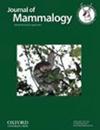亚洲麝:亚种分化、遗传多样性和历史生物地理学
IF 1.6
3区 生物学
Q2 ZOOLOGY
引用次数: 0
摘要
家鼠(Mus musculus)是一种模式生物,为进化研究做出了巨大贡献。尽管它具有重要意义,但我们对其在亚洲地区的系统地理学和种群遗传结构的了解仍然存在差距。这项综合研究旨在阐明麝的进化历史、遗传多样性和分布模式。该研究从亚洲各地收集了 281 个 M. musculus 样本,涵盖 19 个国家的 101 个地点。利用细胞色素b和D-环区域进行的系统发育分析揭示了支持良好的世系。这些世系分别对应于M. m. musculus、M. m. domesticus、M. m. castaneus 和 M. m. bactrianus。此外,M. m. bactrianus 的有效性也受到了质疑。分析表明,这些亚种的单系起源于距今约 59 万年前,其后有两个主系--一个由 M. m. domesticus(约 59 万年前)组成,另一个由 M. m. castaneus、M. m. bactrianus 和 M. m. musculus(约 56 万年前)组成。不同亚种之间的遗传多样性各不相同,其中蓖麻蜥由于广泛分布于全球而表现出最高的多样性,而双耳蓖麻蜥由于局限于亚洲西南部而表现出最低的多样性。成对遗传距离和 Fst 值证实了各亚种之间存在显著的遗传分化,强调了其历史隔离性。此外,Mantel 检验表明,地理距离在形成遗传分化方面起着关键作用。人口统计学分析表明,骡马驯养种、骡马麝香种和骡马蓖麻种有种群扩张的迹象,而双峰骡马麝香种则表现出中性选择和遗传漂变的特征。物种分布模型同时评估了当前状况和末次冰川最盛时期,结果表明在冰川时期,尤其是在亚洲东部和北部地区,栖息地发生了迁移和消失。然而,每个亚种都对气候变化表现出独特的反应,反映出它们不同的生态适应性。历史生物地理学分析表明,亚种的复杂起源以及扩散和替代事件网络导致了亚种在当代的分布。沙漠和干旱灌木地成为物种多样化和分化的关键地区。这项研究有助于我们了解亚洲麝的系统地理学和种群遗传学,突出了地理因素和气候波动在塑造其进化史和遗传多样性方面的重要性。本文章由计算机程序翻译,如有差异,请以英文原文为准。
Asian Mus musculus: subspecies divergence, genetic diversity, and historical biogeography
The House Mouse, Mus musculus, is a model organism that has greatly contributed to evolutionary research. Despite its significance, there remain gaps in our understanding of its phylogeography and population genetic structure in Asian regions. This comprehensive study aims to elucidate the evolutionary history, genetic diversity, and distribution patterns of M. musculus. A diverse data set of 281 M. musculus samples was collected from across Asia, covering 101 localities in 19 countries. Phylogenetic analysis using Cytochrome b and D-Loop region unveiled well-supported lineages. These lineages correspond to: M. m. musculus, M. m. domesticus, M. m. castaneus, and M. m. bactrianus. Also, validity of M. m. bactrianus was questioned. The analysis suggests a monophyletic origin of these subspecies approximately 0.59 million years ago (Mya), followed by 2 main lineages—one consisting of M. m. domesticus (~0.59 Mya) and the other comprising M. m. castaneus, M. m. bactrianus, and M. m. musculus (~0.56 Mya). Genetic diversity varied among subspecies, with M. m. domesticus exhibiting the highest diversity due to its extensive global distribution and M. m. bactrianus exhibiting the lowest diversity due to restriction in southwest Asia. Pairwise genetic distances and Fst values confirmed significant genetic differentiation among the subspecies, underlining their historical isolation. Additionally, a Mantel test indicated that geographical distance played a pivotal role in shaping genetic differentiation. Demographic analysis revealed evidence of population expansions in M. m. domesticus, M. m. musculus, and M. m. castaneus, while M. m. bactrianus showed characteristics of neutral selection and genetic drift. Species distribution modeling, assessing both Current Conditions and the Last Glacial Maximum, indicated habitat shifts and losses during glacial periods, particularly in the eastern and northern regions of Asia. However, each subspecies displayed unique responses to climatic changes, reflecting their distinct ecological adaptations. Historical biogeography analysis pointed to complex origins and a network of dispersal and vicariance events that led to the contemporary distribution of subspecies. Deserts and xeric shrublands emerged as critical areas for diversification and speciation. This study contributes to our understanding of the phylogeography and population genetics of M. musculus in Asia, highlighting the significance of geographical factors and climatic fluctuations in shaping its evolutionary history and genetic diversity.
求助全文
通过发布文献求助,成功后即可免费获取论文全文。
去求助
来源期刊

Journal of Mammalogy
生物-动物学
CiteScore
3.30
自引率
5.90%
发文量
106
审稿时长
4-8 weeks
期刊介绍:
Papers are published on mammalian behavior, conservation, ecology, genetics, morphology, physiology, and taxonomy.
 求助内容:
求助内容: 应助结果提醒方式:
应助结果提醒方式:


